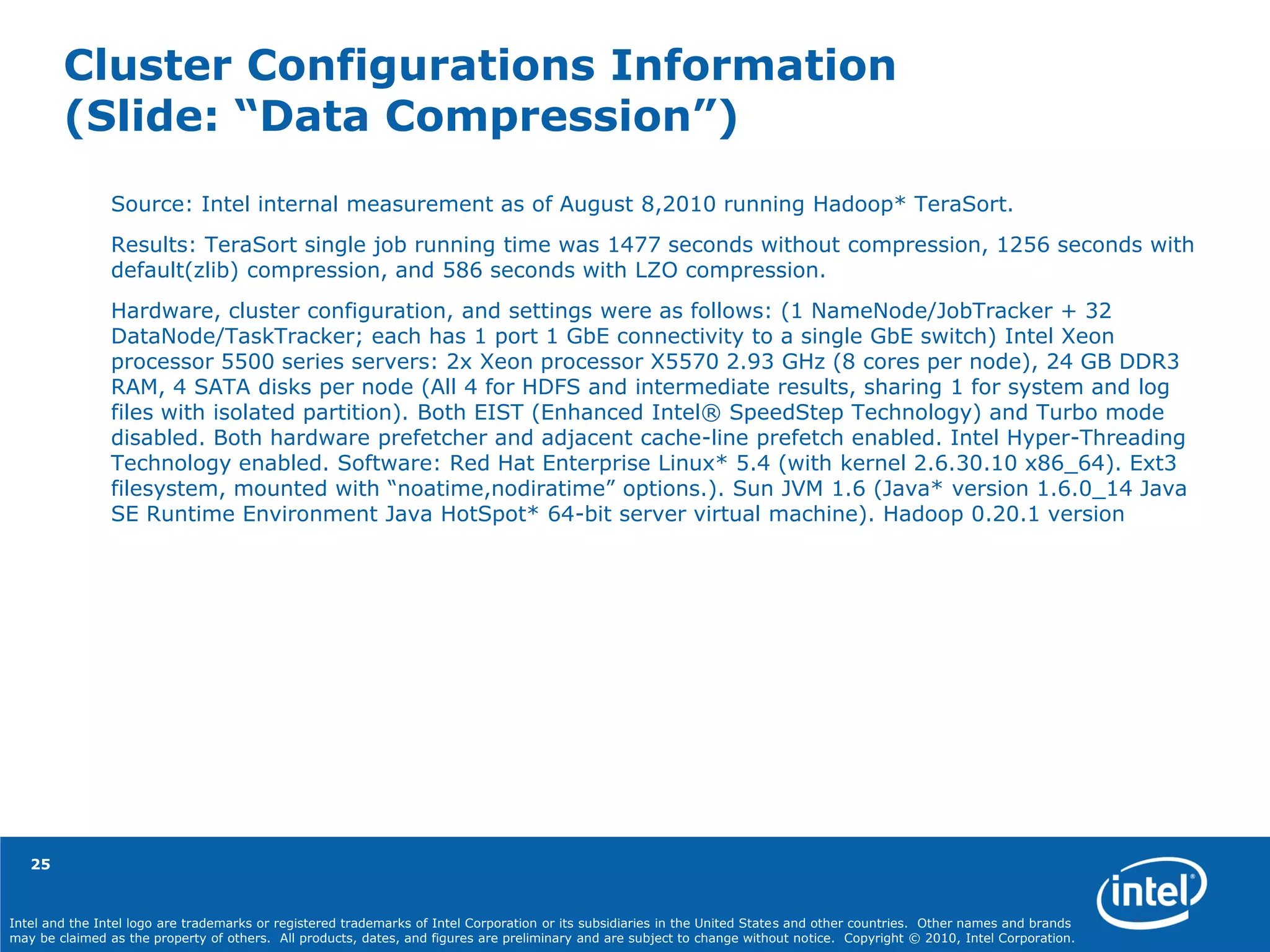The document discusses optimizing Hadoop workloads, highlighting the importance of hardware and software configurations to improve efficiency and performance. Key recommendations include processor selection, memory allocation, disk drive setup, and specific settings for the Hadoop environment. The document outlines how various optimizations can significantly enhance data handling capabilities while reducing costs and time.
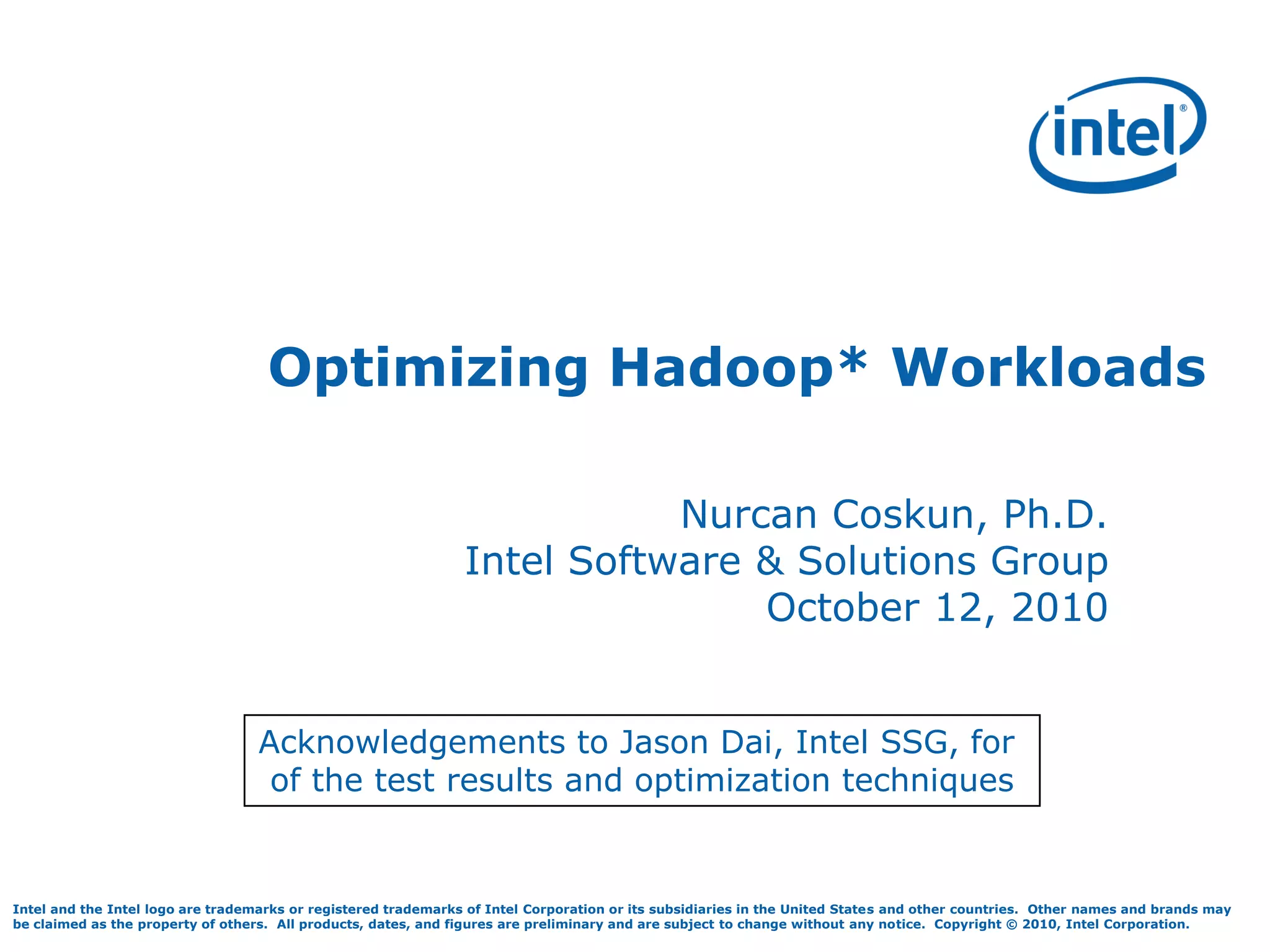

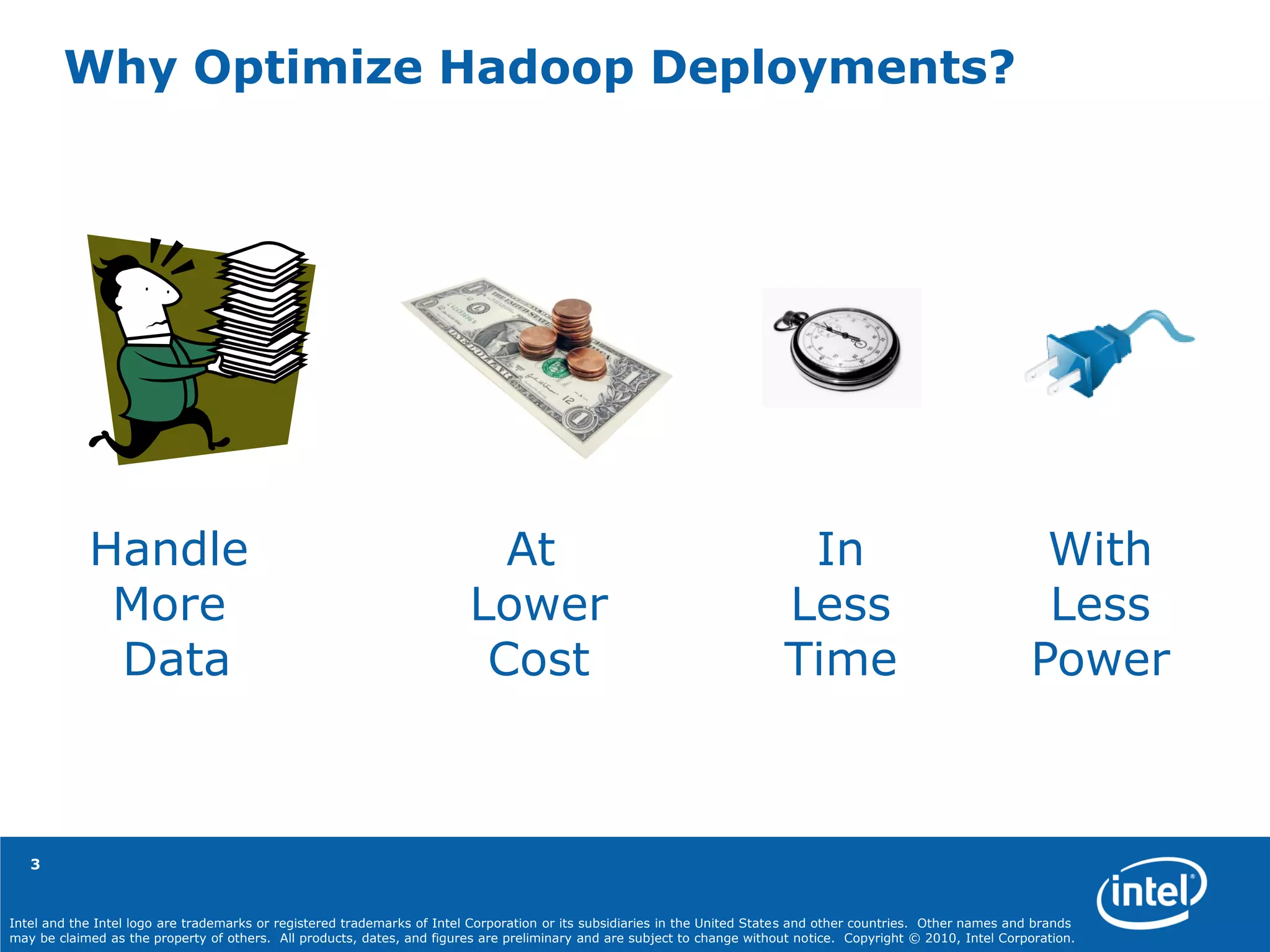
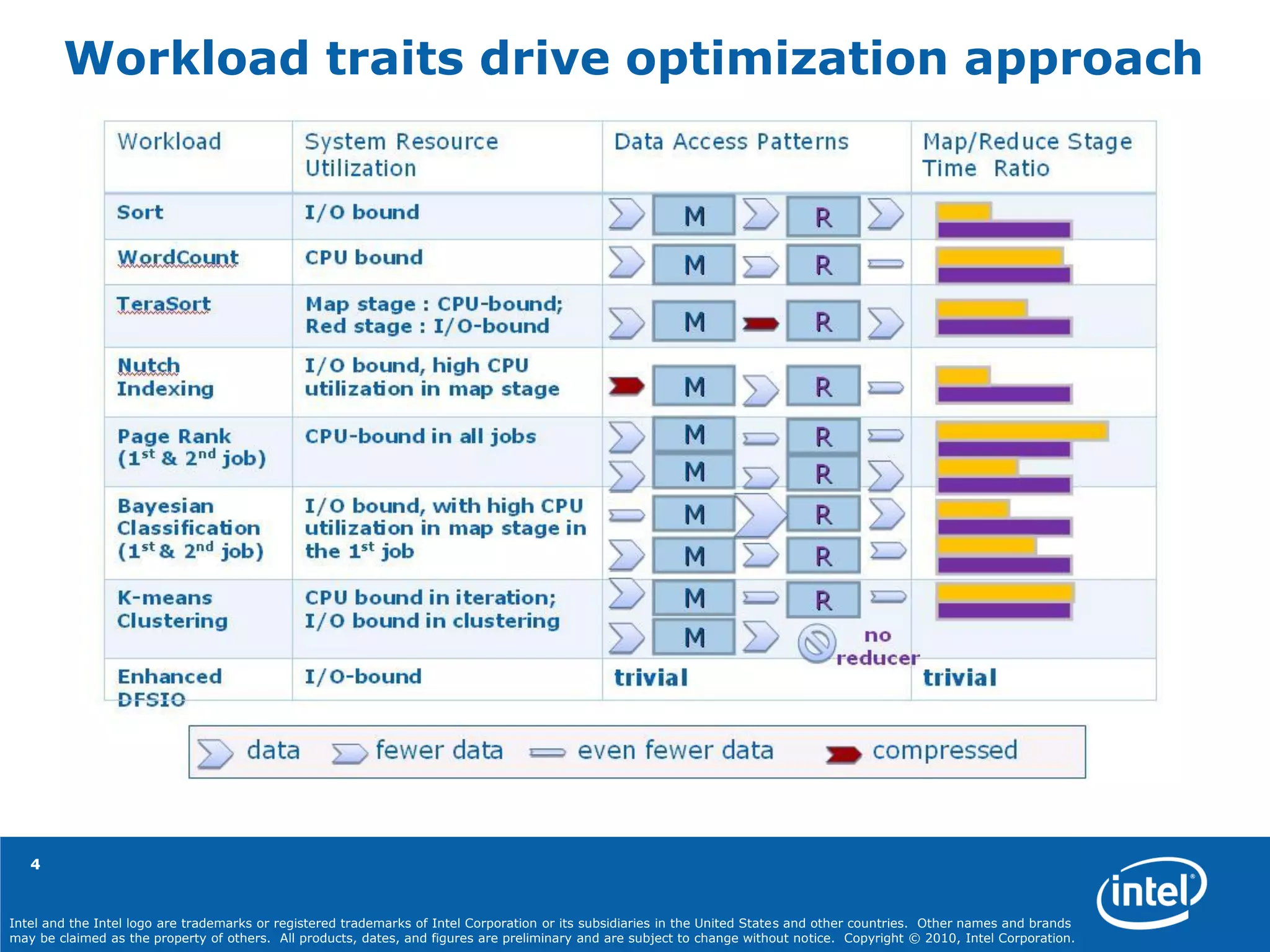
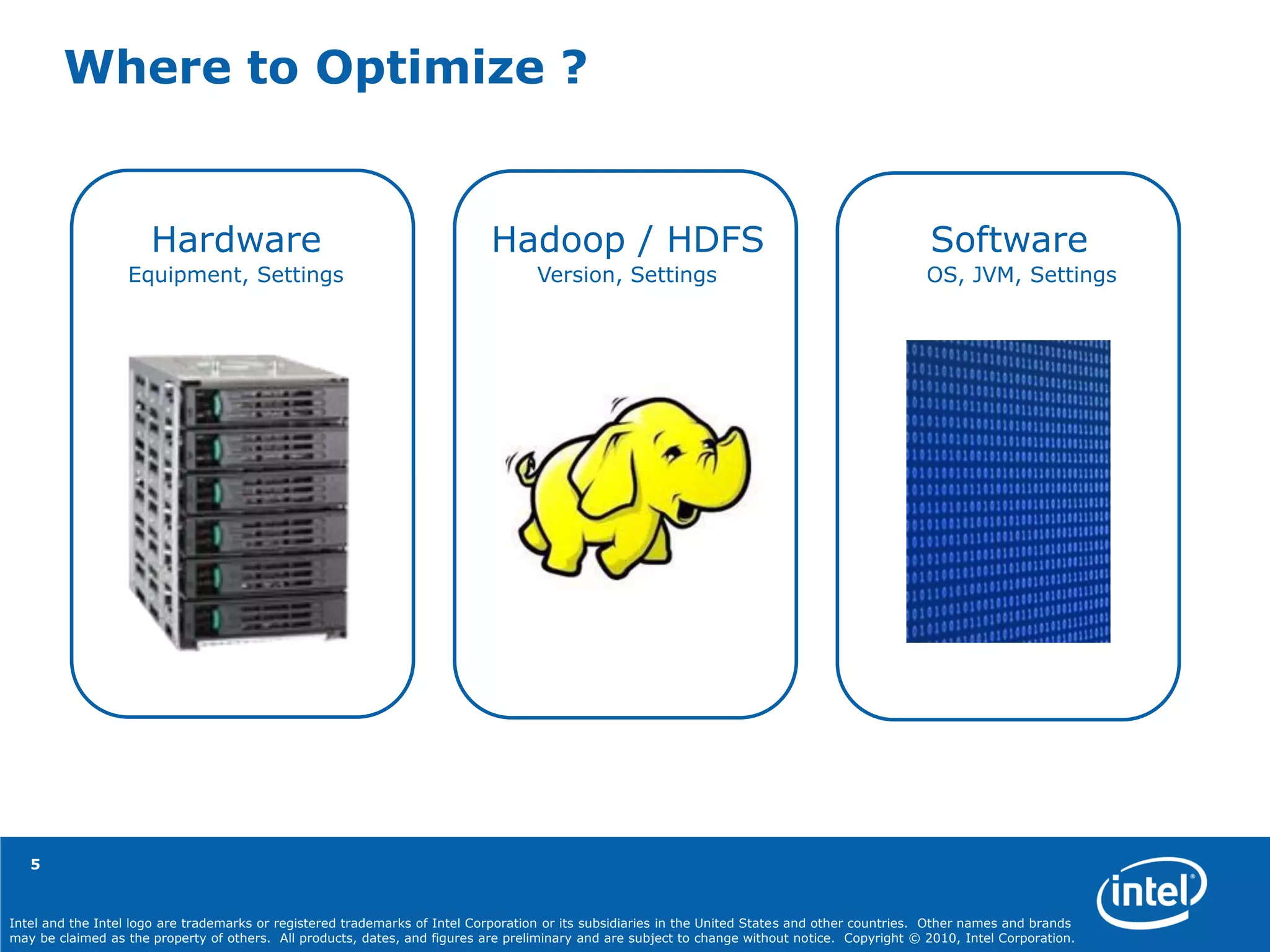
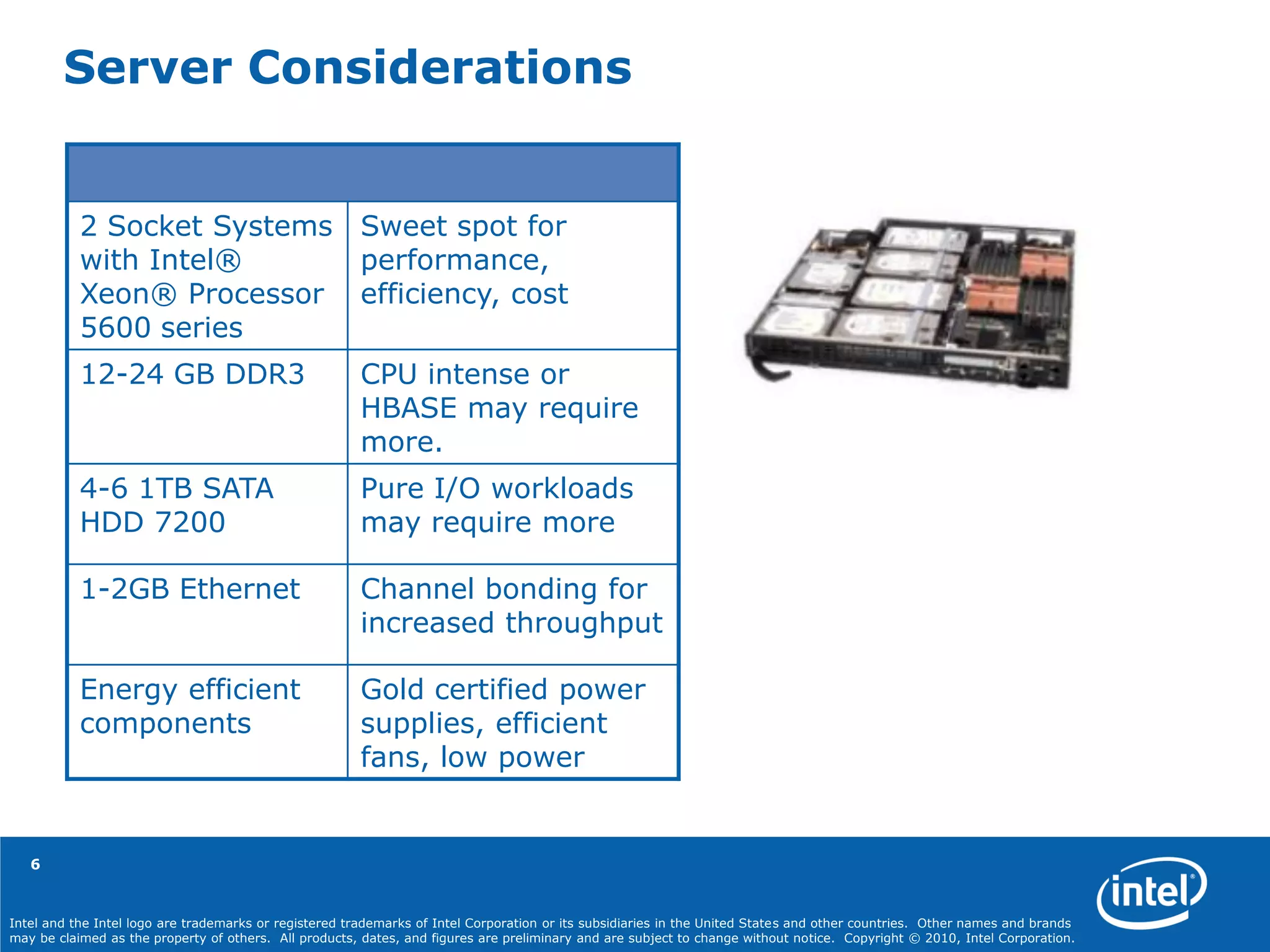
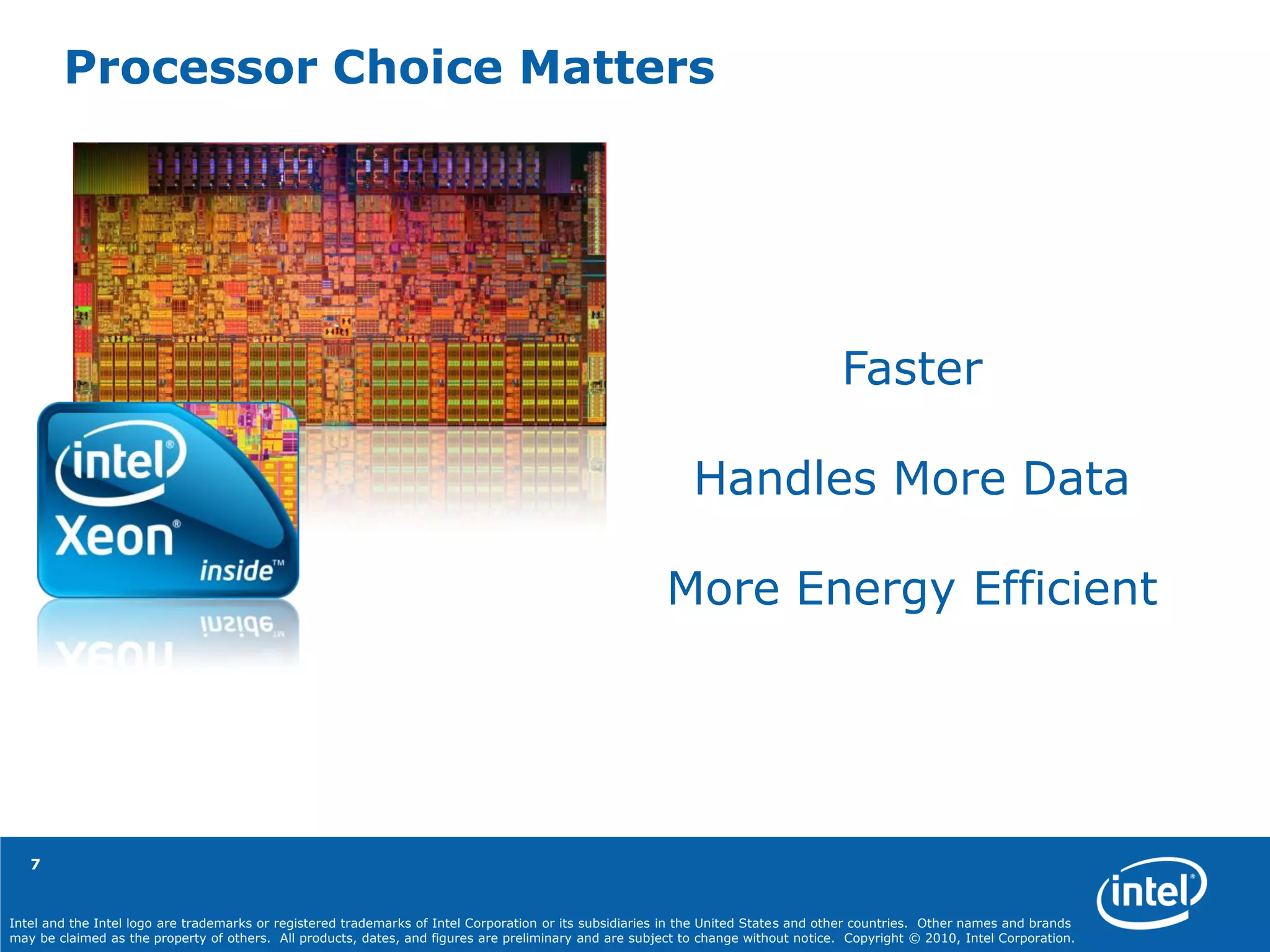
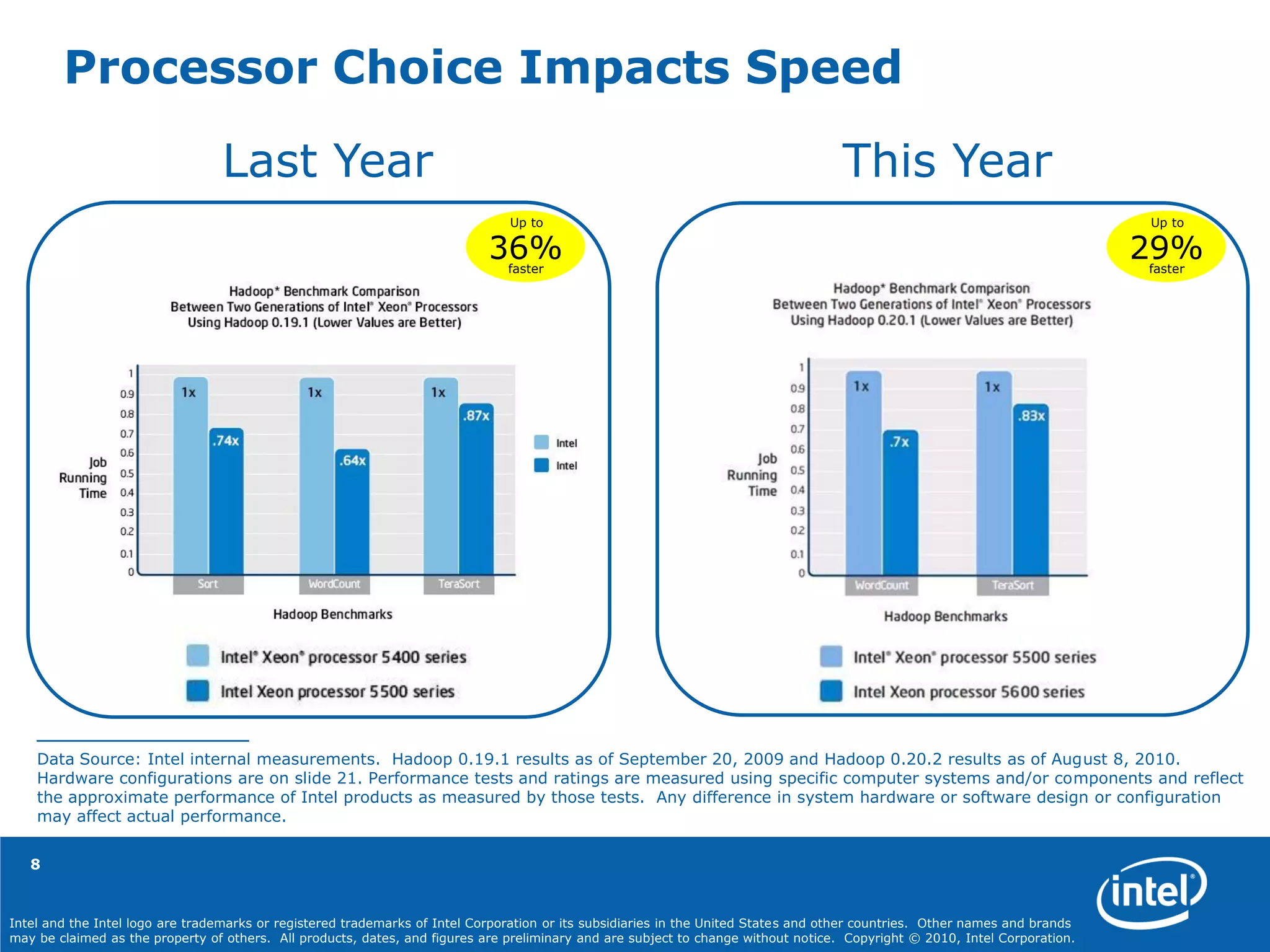
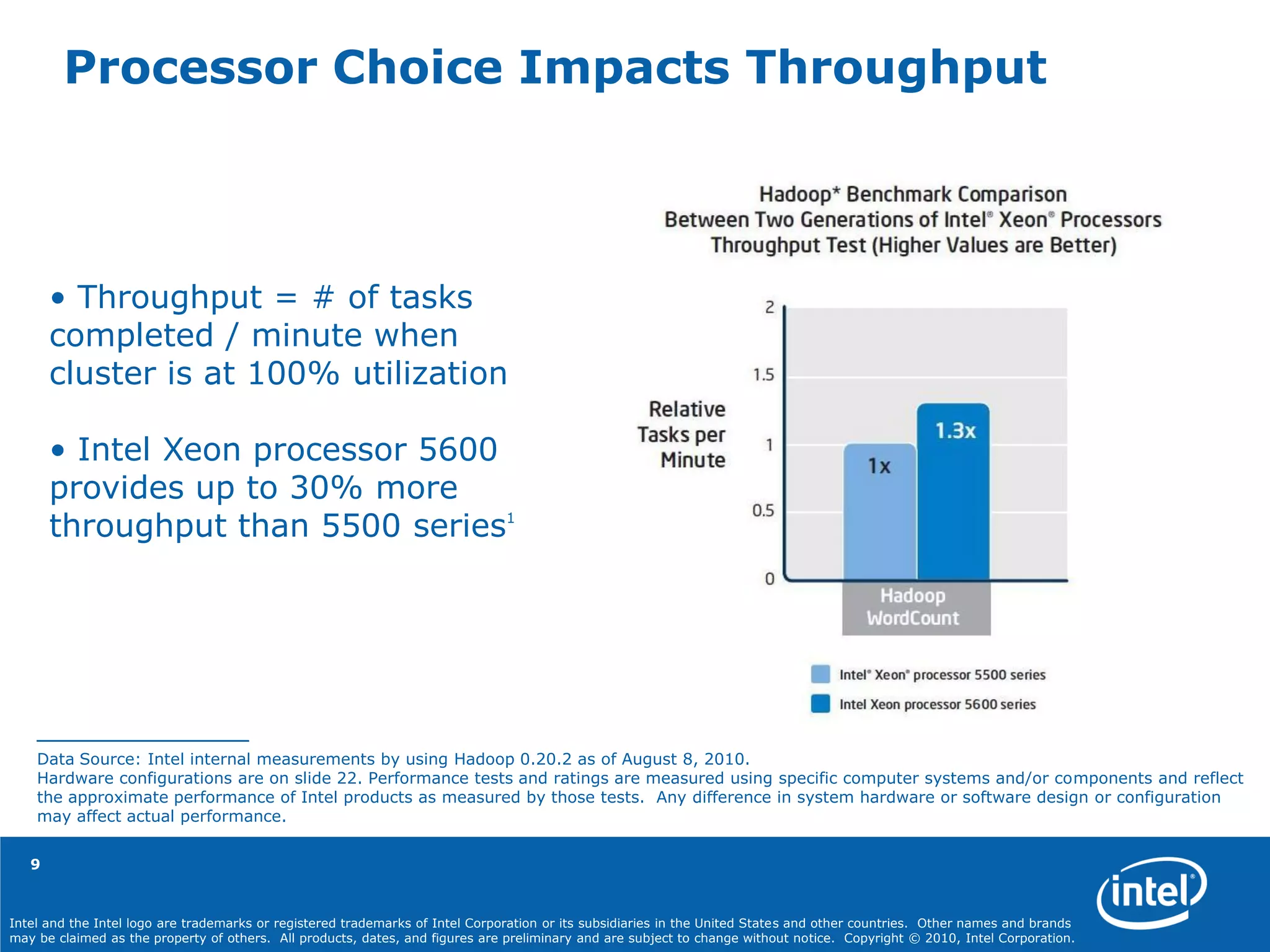
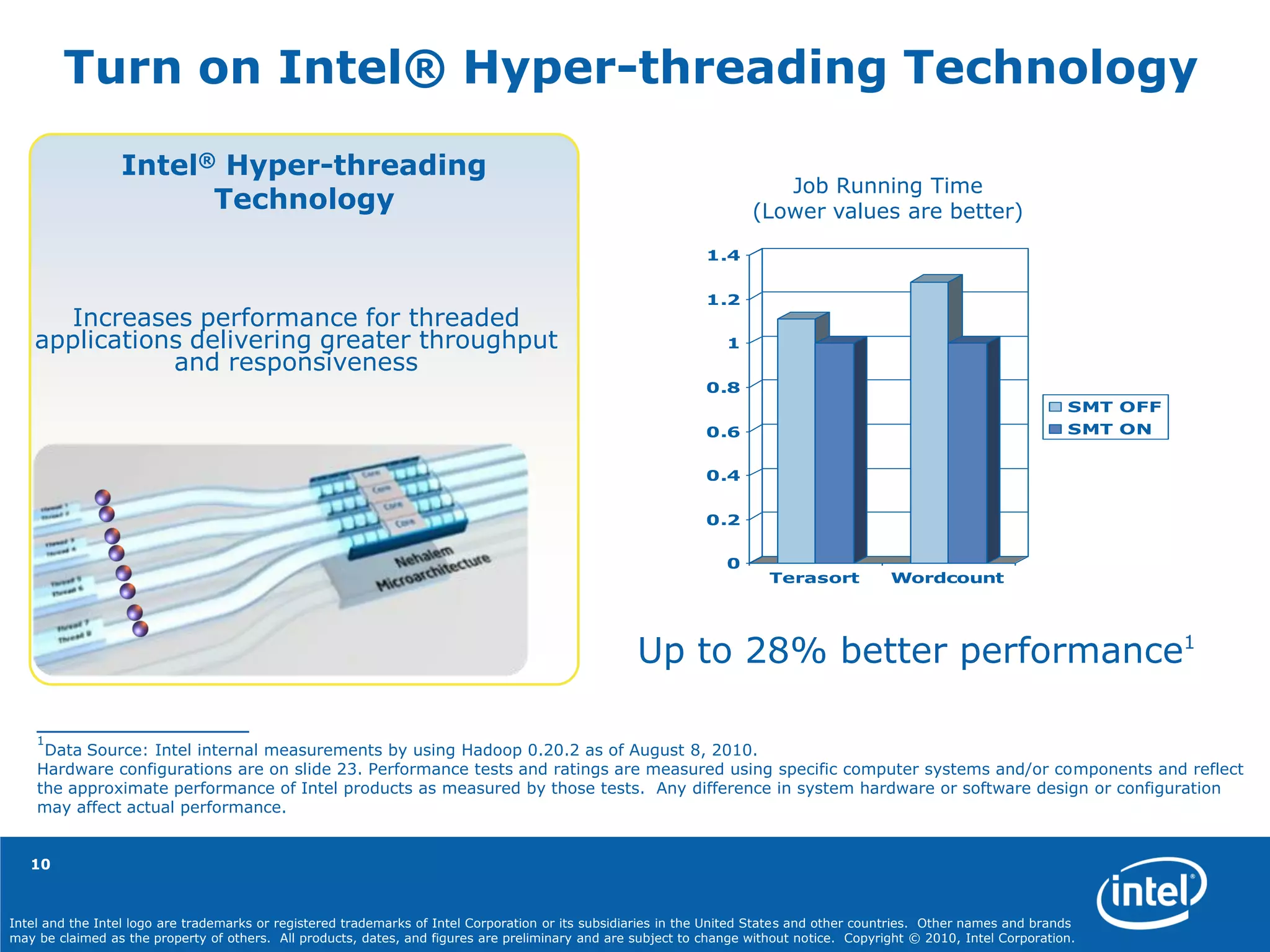
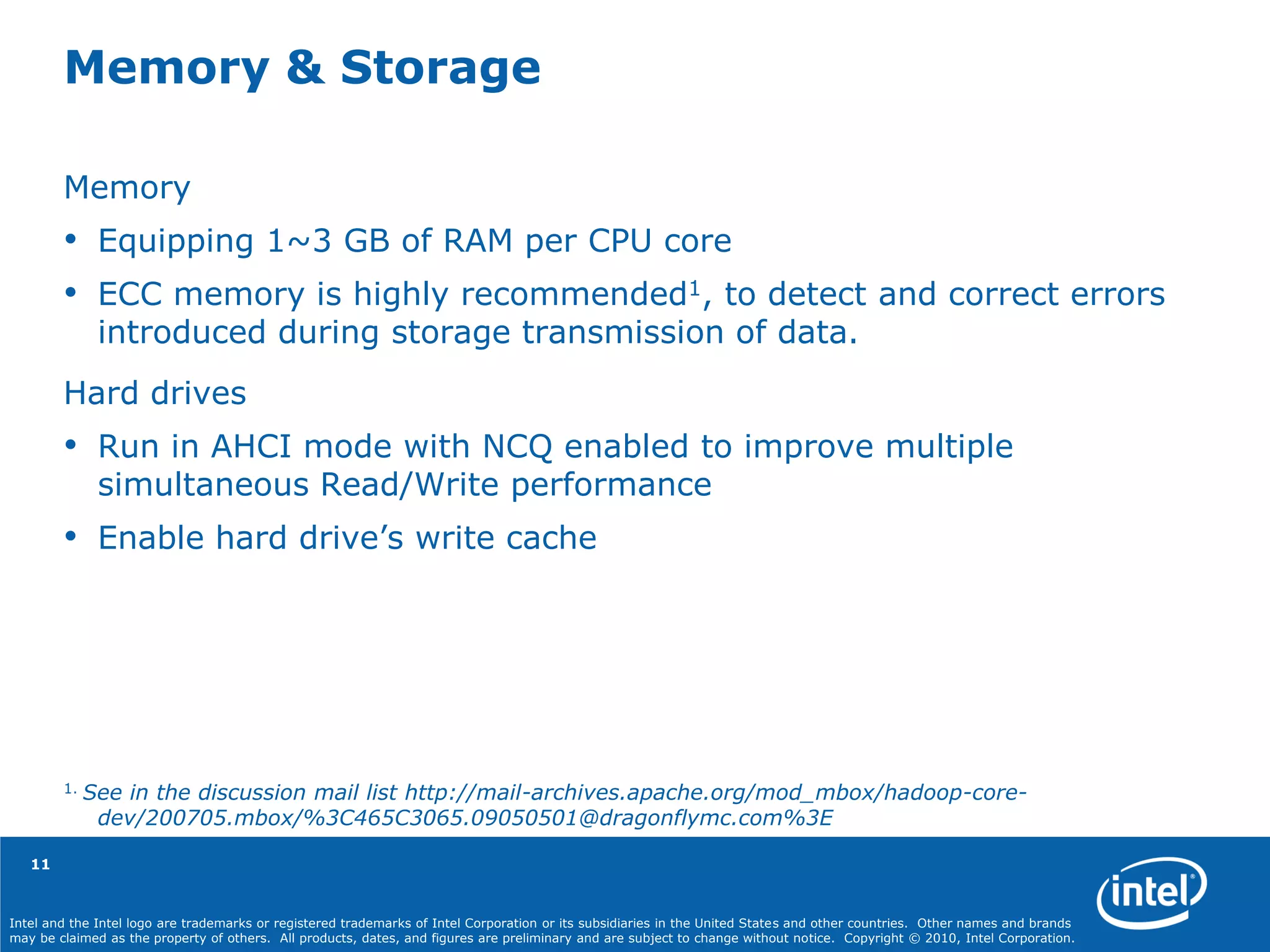

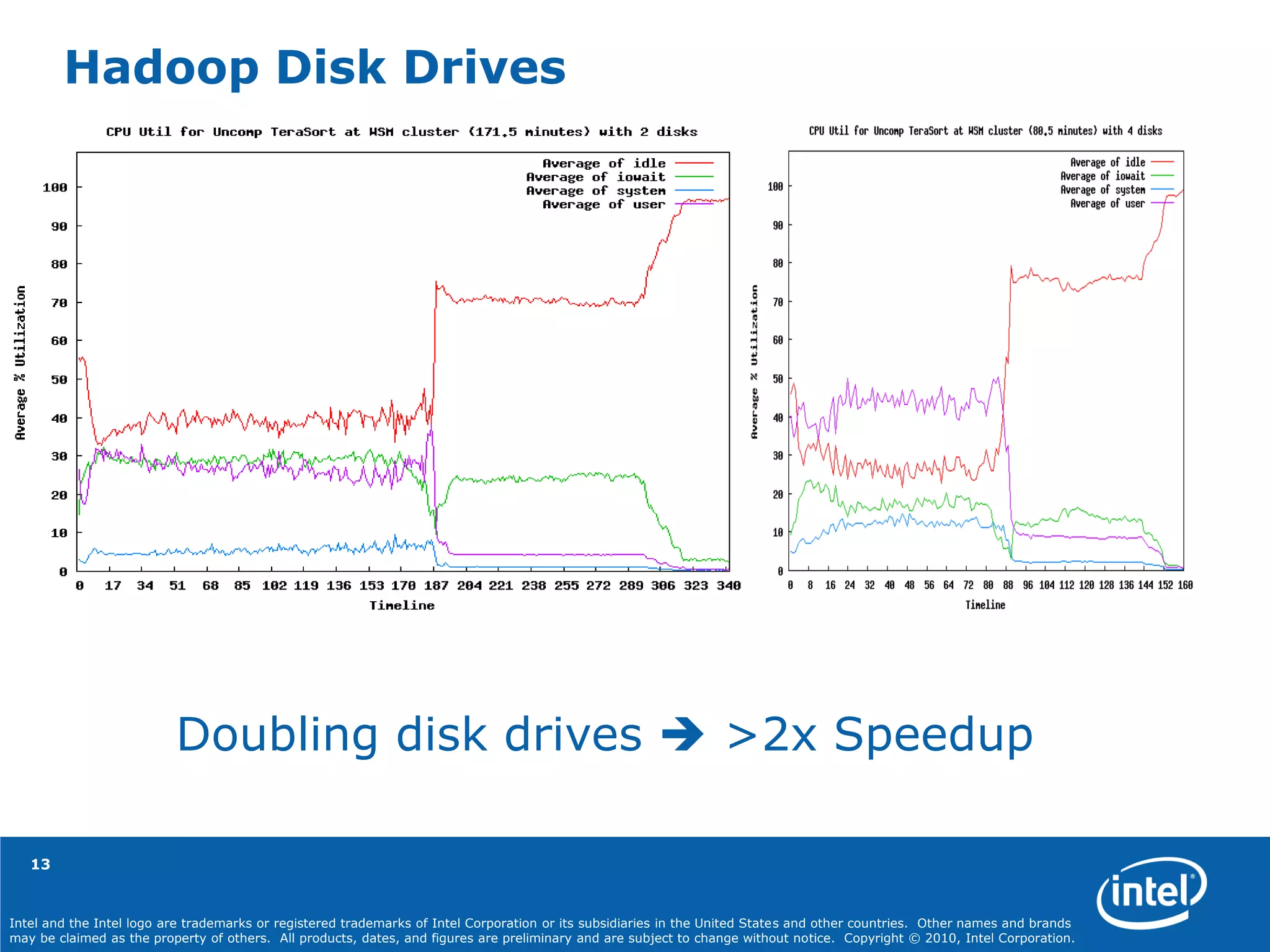
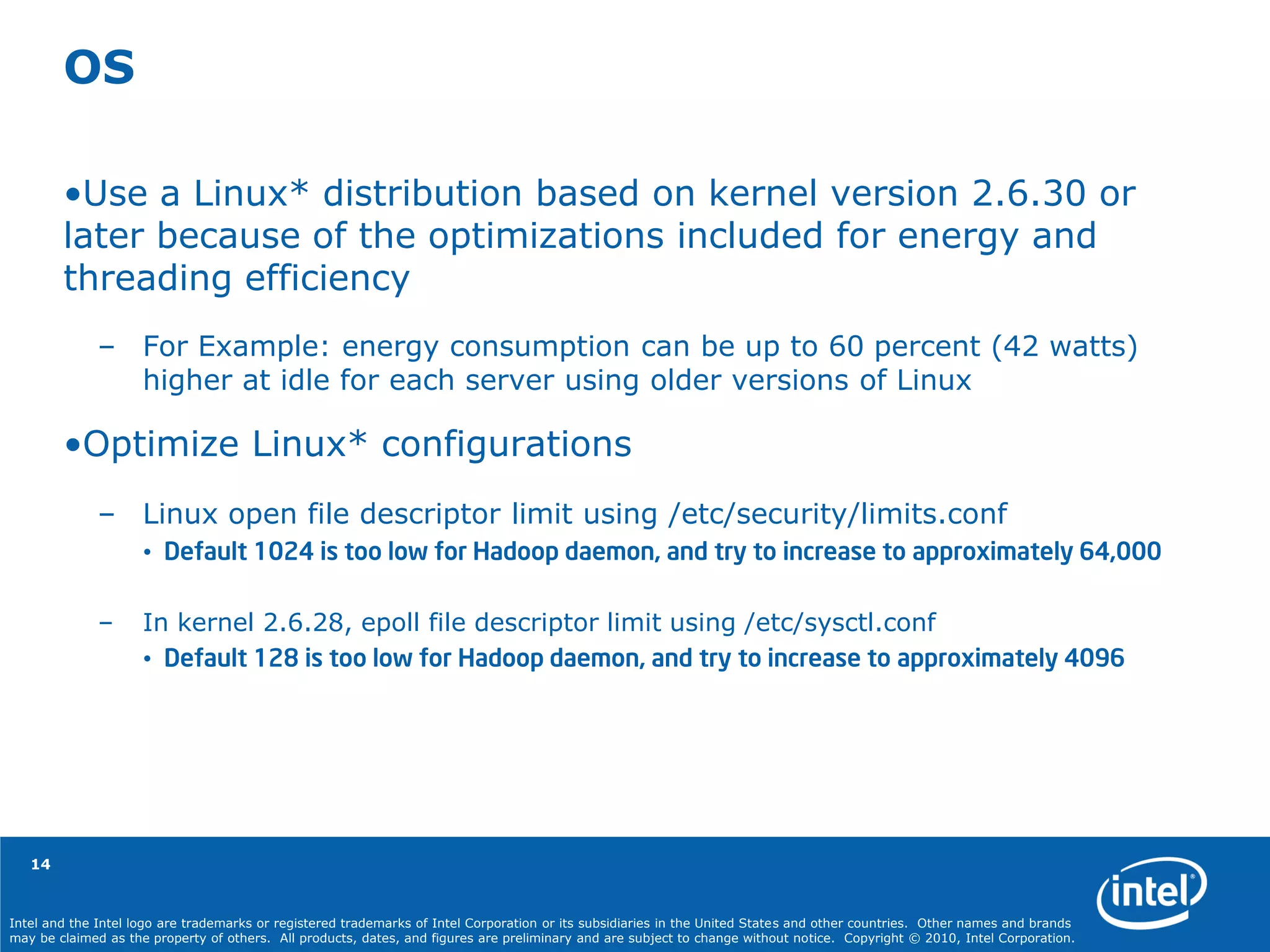
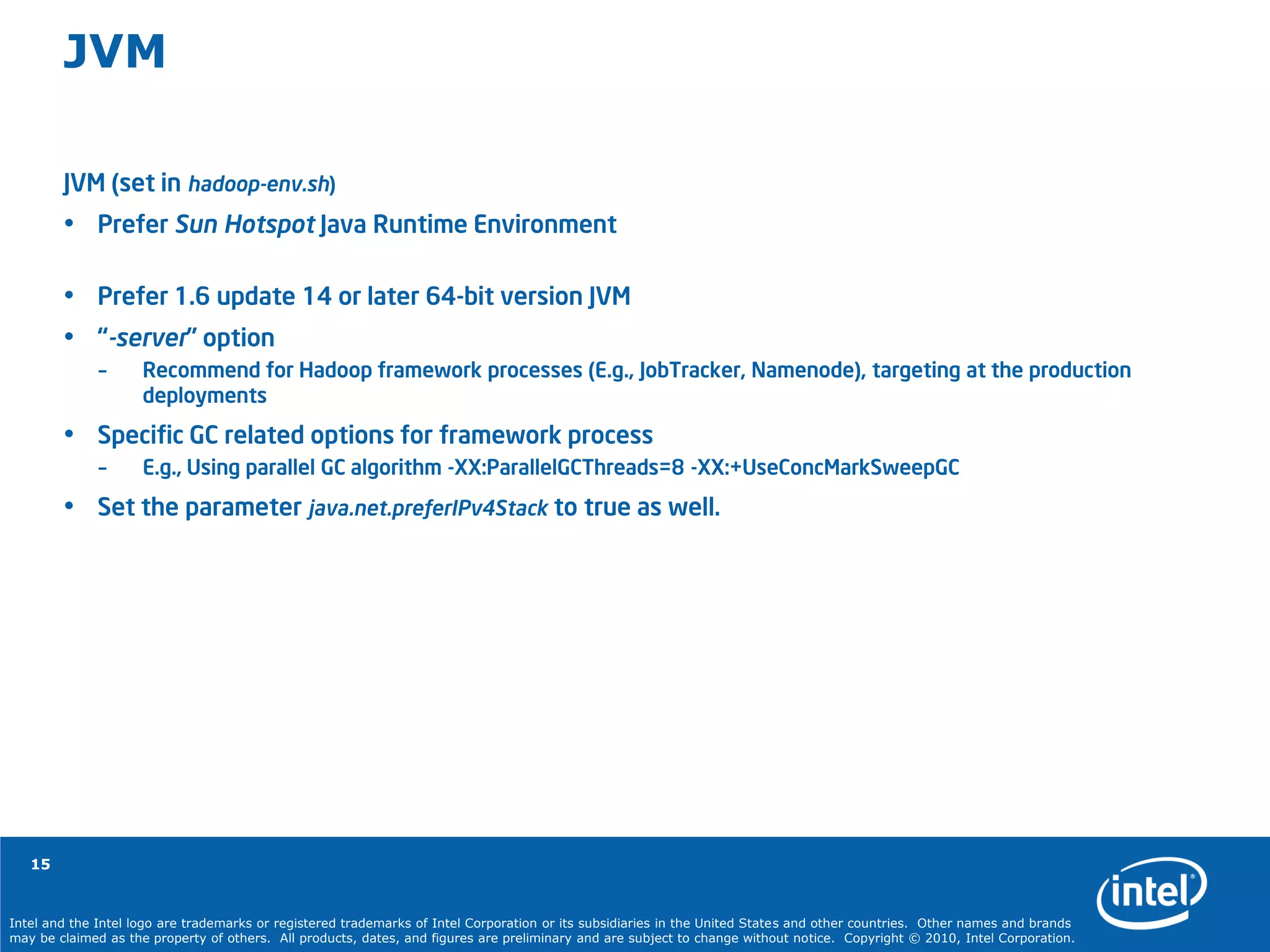
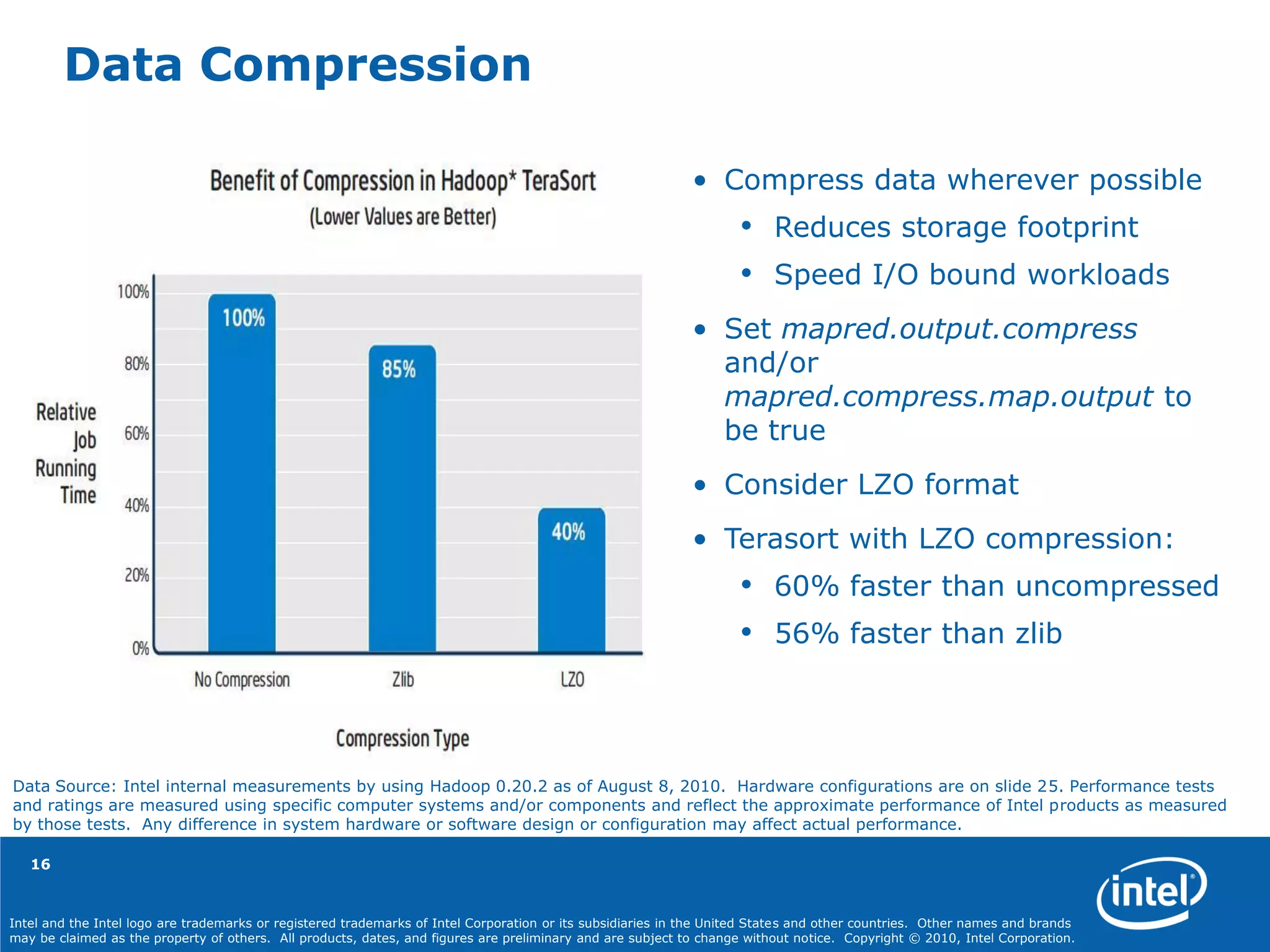
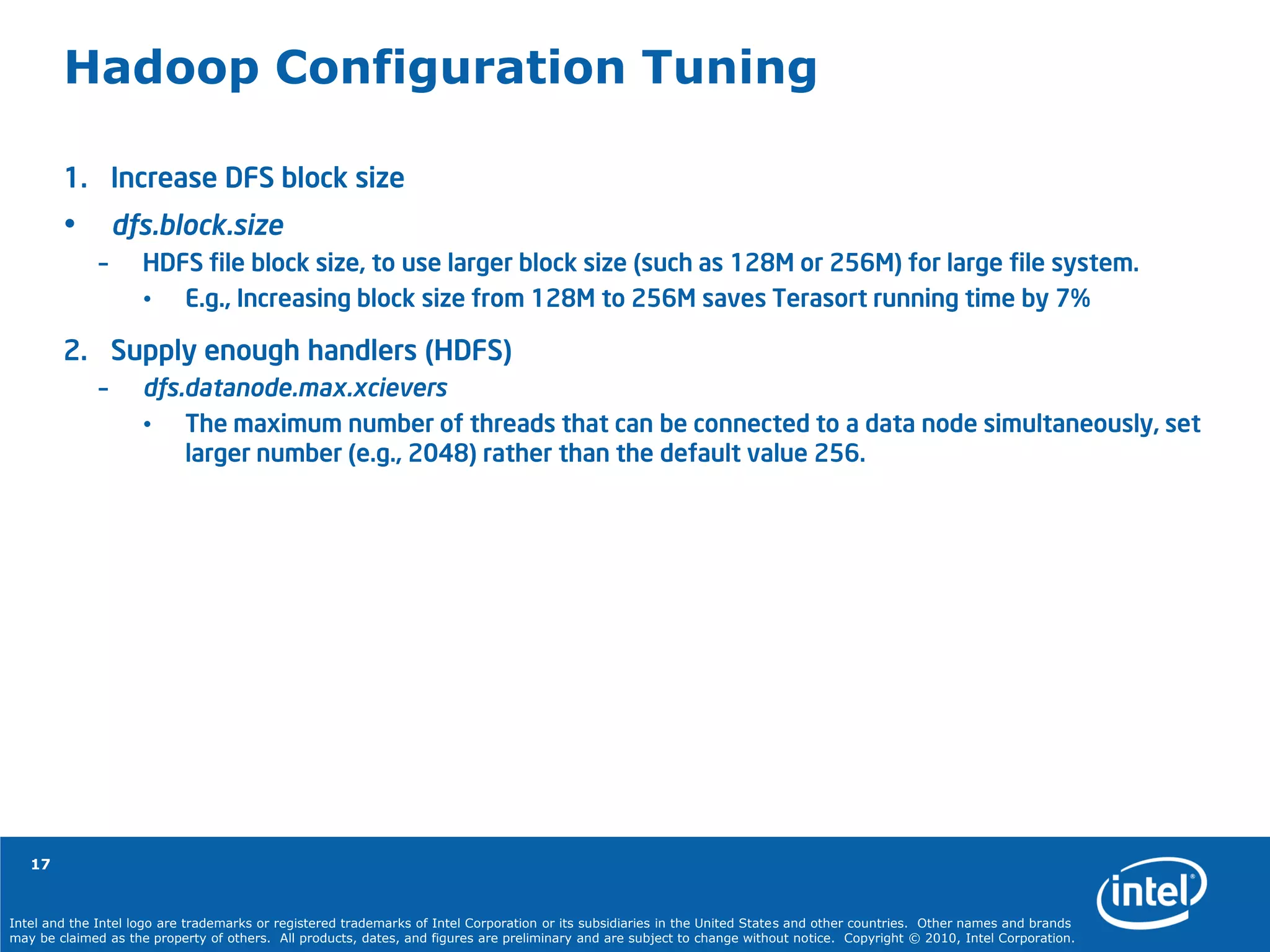
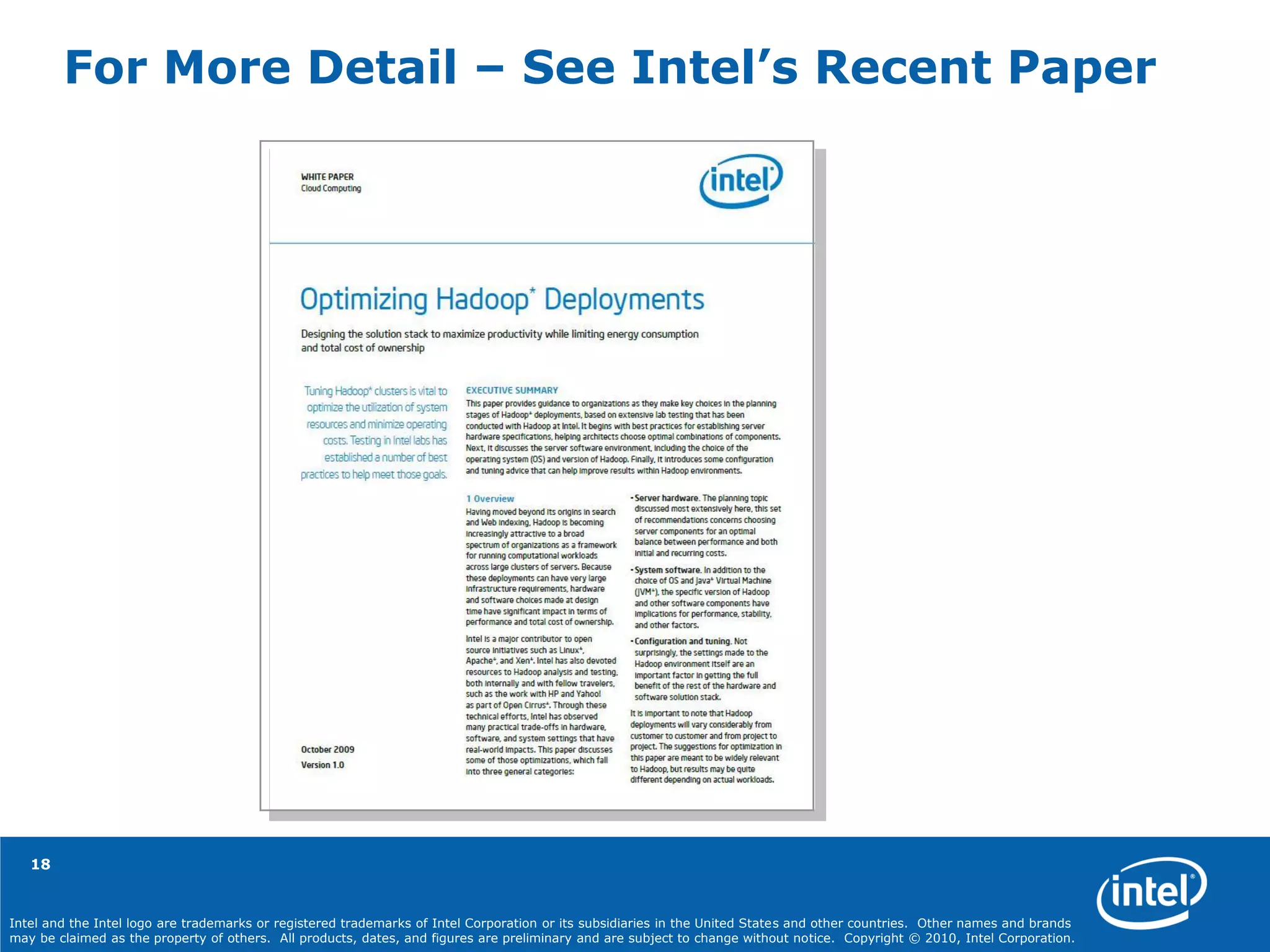

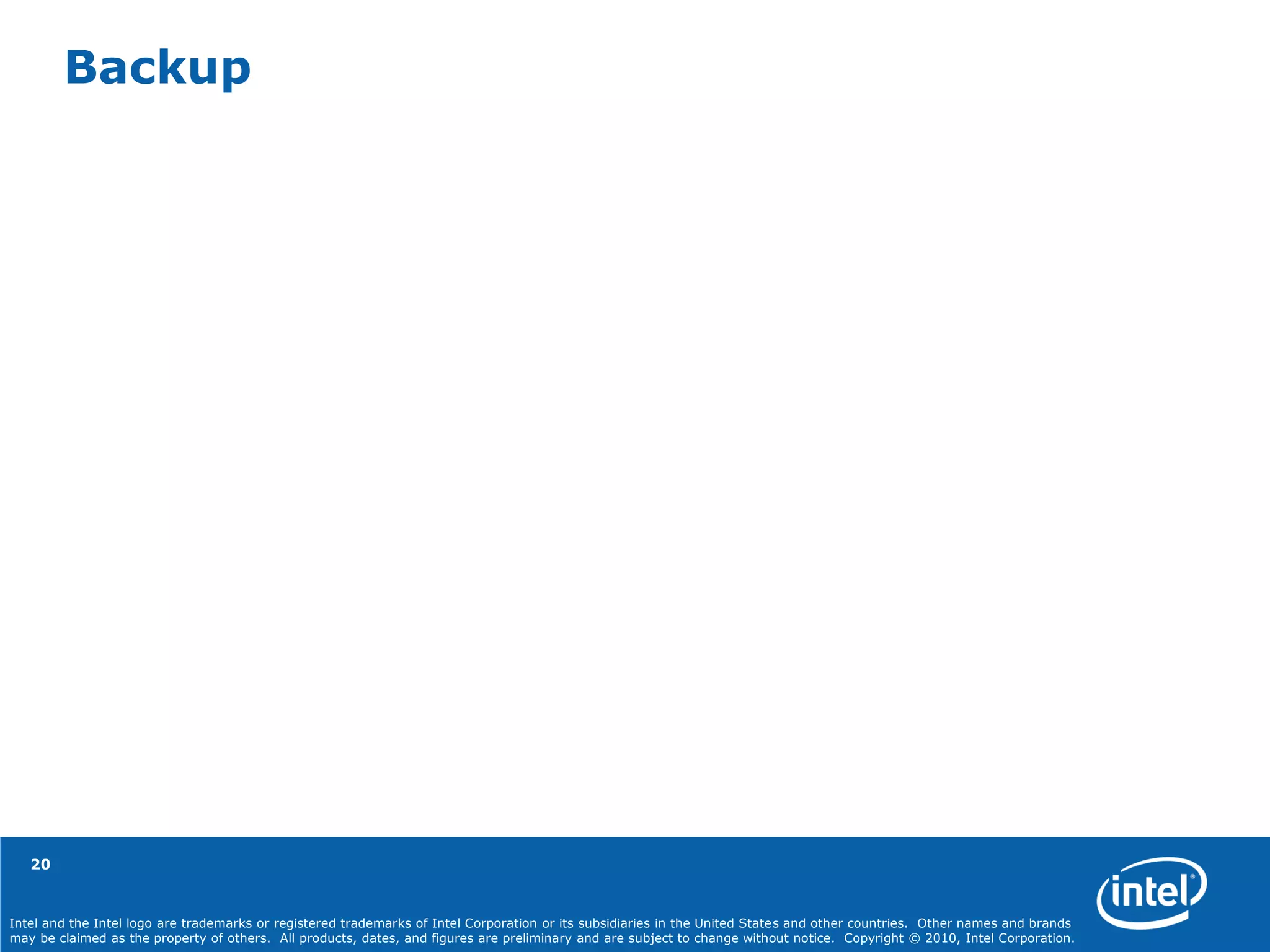
![Intel and the Intel logo are trademarks or registered trademarks of Intel Corporation or its subsidiaries in the United States and other countries. Other names and brands
may be claimed as the property of others. All products, dates, and figures are preliminary and are subject to change without notice. Copyright © 2010, Intel Corporation.
Cluster Configurations Information
(Slide: “Processor Choice Impacts Speed”)
Source: Intel internal measurement as of September 19 2009 running Hadoop*, WordCount, and TeraSort
Intel® Xeon® X5460-based server
Processor: Dual-socket quad-core Intel® Xeon® X5460 3.16GHz
Processor Memory: 16GB (DDR2 FBDIM ECC 667MHz) RAM
Storage: 1 X 300GB 15K RPM SAS disk for system and log files, 4 X 1TB 7200RPM SATA for HDFS and intermediate results
Network: 1 Gigabit Ethernet NIC
BIOS: BIOS version S5000.86B.10.60.0091.100920081631EIST (Enhanced Intel SpeedStep Technology) disabled both hardware prefetcher and
adjacent cache-line, prefetch disable
Intel® Xeon® X5570-based server
Processor: Dual-socket quad-core Intel® Xeon® X5570 2.93GHz
Processor Memory: 16GB (DDR3 ECC 1333MHz) RAM
Storage: 1 X 1TB 7200RPM SATA for system and log files, 4 X 1TB 7200RPM SATA for HDFS and intermediate results
Network: 1 Gigabit Ethernet NIC
BIOS: BIOS version 4.6.3 Both EIST (Enhanced Intel SpeedStep Technology) and Turbo mode disabled both hardware prefetcher and adjacent cache-
line prefetch enabled, SMT (Simultaneous MultiThreading), enabled (Disabling hardware prefetcher and adjacent cache-line prefetch helps improve
Hadoop performance on Xeon X5460 server according to our benchmarking.)
Source: Intel internal measurement as of August 8, 2010 running Hadoop* WordCount and TeraSort.
Results: WordCount single job running time was 407 seconds on the Xeon® 5500® processor series and 289 seconds on the Intel® Xeon® 5600
processor series. TeraSort single job running time was 2,541 seconds on the Xeon processor 5500 series and 2,182 seconds on the Intel Xeon processor
5600 series.
Hardware, cluster configuration, and settings were as follows:
(1 Namenode/JobTracker + 5 DataNode/TaskTracker, each has two port 1 GbE connectivity to a single GbE switch with channel bonding enabled.) Intel
Xeon processor 5600 series servers: HP ProLiant* z6000 G6 Server with 2x Intel® Xeon® processor X5670 2.93 GHz (12 cores per node), 24 GB DDR3
RAM, 6 SATA disks per node (All six for HDFS and intermediate results, sharing one for system and log files with isolated partition). Both EIST
(Enhanced Intel® SpeedStep Technology) and Turbo mode disabled. Both hardware prefetcher and adjacent cache-line prefetch enabled. Intel® Hyper-
Threading Technology enabled. Intel Xeon processor 5500 series servers: HP ProLiant z6000 G6 Server with 2x Intel® Xeon® processor X5570 2.93
GHz (8 cores per node), 24 GB DDR3 RAM, 6 SATA disks per node (All six for HDFS and intermediate results, sharing one for system and log files with
isolated partition). Both EIST (Enhanced Intel® SpeedStep Technology) and Turbo mode disabled. Both hardware prefetcher and adjacent cache-line
prefetch enabled. Intel Hyper-Threading Technology enabled. Software: Red Hat Enterprise Linux* 5.4 (with kernel 2.6.30x86_64). Ext4 file system,
mounted with “noatime,nodiratime” options.). Sun JVM 1.6 (Java* version 1.6.0_14 Java SE Runtime Environment Java HotSpot* 64-bit server virtual
machine). Cloudera distribution of Hadoop [hadoop-0.20.2-CDH3 beta 2 (hadoop patch level 320)].
21](https://image.slidesharecdn.com/optimizinghadoop-intelpresentation-oct122010-101026152812-phpapp01/75/Intel-Nurcan-Coskun-Hadoop-World-2010-21-2048.jpg)
![Intel and the Intel logo are trademarks or registered trademarks of Intel Corporation or its subsidiaries in the United States and other countries. Other names and brands
may be claimed as the property of others. All products, dates, and figures are preliminary and are subject to change without notice. Copyright © 2010, Intel Corporation.
Cluster Configurations Information
(Slide: “Processor Choice Impacts Throughput”)
Source: Intel internal measurement as of August 8, 2010 running Hadoop* WordCount and TeraSort.
Results: Total completed tasks per minute of WordCount over Intel® Xeon® processor 5500 series
was approximately 71.58, and over Intel® Xeon® process 5600 series was approximately 93.22.
Hardware, cluster configuration, and settings were as follows:
(1 Namenode/JobTracker + 5 DataNode/TaskTracker, each has two port 1 GbE connectivity to a
single GbE switch with channel bonding enabled.) Intel Xeon processor 5600 series servers: HP
ProLiant* z6000 G6 Server with 2x Intel Xeon processor X5670 2.93 GHz (12 cores per node), 24 GB
DDR3 RAM, 6 SATA disks per node (All six for HDFS and intermediate results, sharing one for system
and log files with isolated partition). Both EIST (Enhanced Intel® SpeedStep Technology) and Turbo
mode disabled. Both hardware prefetcher and adjacent cache-line prefetch enabled. Intel® Hyper-
Threading Technology enabled. Intel Xeon processor 5500 series servers: HP ProLiant z6000 G6
Server with 2x Intel Xeon processor X5570 2.93 GHz (8 cores per node), 24 GB DDR3 RAM, 6 SATA
disks per node (All six for HDFS and intermediate results, sharing one for system and log files with
isolated partition). Both EIST (Enhanced Intel® SpeedStep Technology) and Turbo mode disabled.
Both hardware prefetcher and adjacent cache-line prefetch enabled. Intel Hyper-Threading
Technology enabled. Software: Red Hat Enterprise Linux* 5.4 (with kernel 2.6.30x86_64). Ext4 file
system, mounted with “noatime,nodiratime” options.). Sun JVM 1.6 (Java* version 1.6.0_14 Java SE
Runtime Environment Java HotSpot* 64-bit server virtual machine). Cloudera distribution of Hadoop
[hadoop-0.20.2-CDH3 beta 2 (hadoop patch level 320)]
22](https://image.slidesharecdn.com/optimizinghadoop-intelpresentation-oct122010-101026152812-phpapp01/75/Intel-Nurcan-Coskun-Hadoop-World-2010-22-2048.jpg)
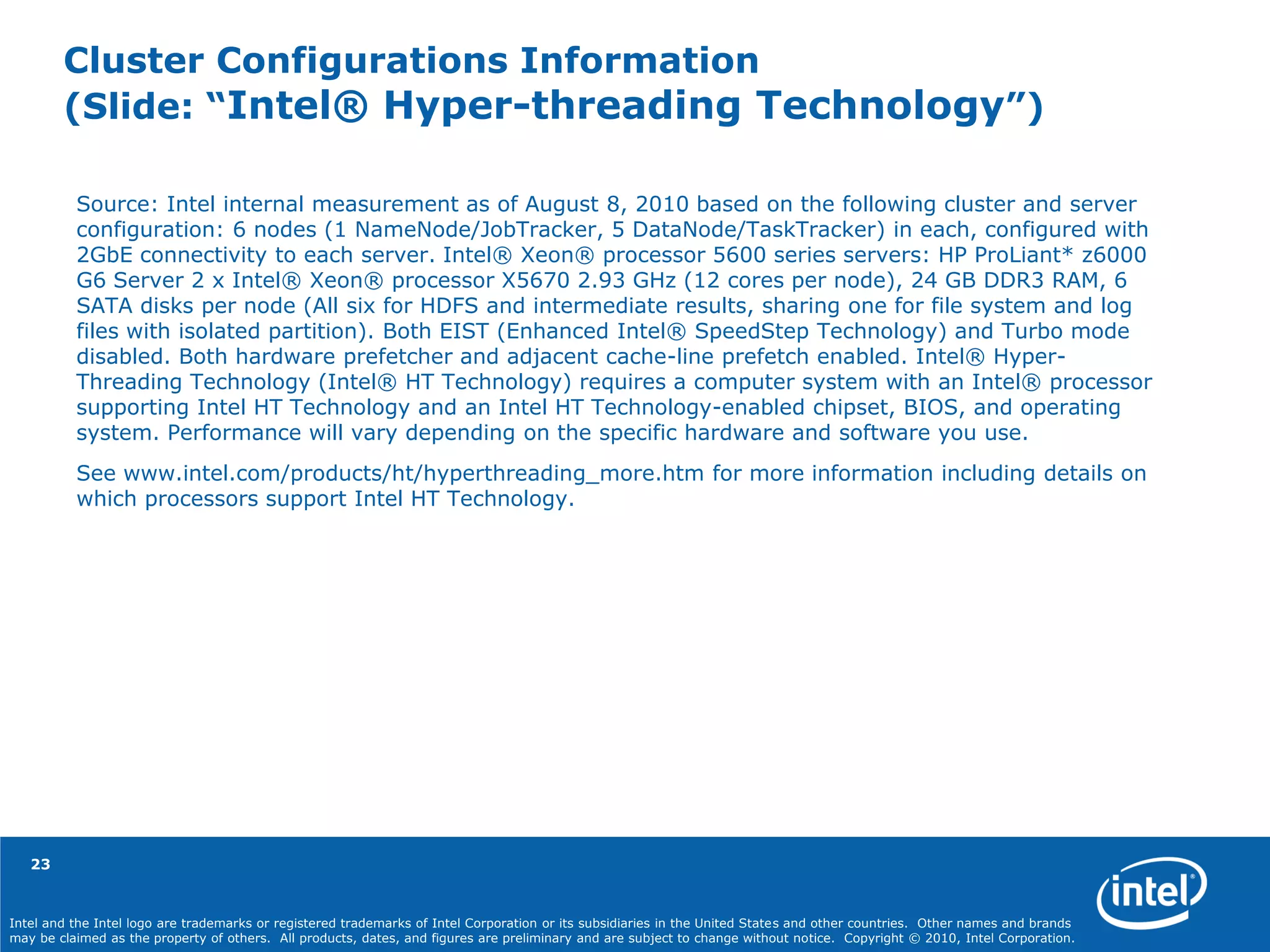
![Intel and the Intel logo are trademarks or registered trademarks of Intel Corporation or its subsidiaries in the United States and other countries. Other names and brands
may be claimed as the property of others. All products, dates, and figures are preliminary and are subject to change without notice. Copyright © 2010, Intel Corporation.
Cluster Configurations Information
(Slide: “Networking”)
24
Source: Intel internal measurement as of August 8, 2010 running Hadoop* WordCount and TeraSort.
Hardware, cluster configuration, and settings were as follows:
(1 Namenode/JobTracker + 5 DataNode/TaskTracker, each has two port 1 GbE connectivity to a single
GbE switch with channel bonding enabled.) Intel Xeon processor 5600 series servers: HP ProLiant*
z6000 G6 Server with 2x Intel Xeon processor X5670 2.93 GHz (12 cores per node), 24 GB DDR3
RAM, 6 SATA disks per node (All six for HDFS and intermediate results, sharing one for system and
log files with isolated partition). Both EIST (Enhanced Intel® SpeedStep Technology) and Turbo mode
disabled. Both hardware prefetcher and adjacent cache-line prefetch enabled. Intel® Hyper-Threading
Technology enabled. Intel Xeon processor 5500 series servers: HP ProLiant z6000 G6 Server with 2x
Intel Xeon processor X5570 2.93 GHz (8 cores per node), 24 GB DDR3 RAM, 6 SATA disks per node
(All six for HDFS and intermediate results, sharing one for system and log files with isolated
partition). Both EIST (Enhanced Intel® SpeedStep Technology) and Turbo mode disabled. Both
hardware prefetcher and adjacent cache-line prefetch enabled. Intel Hyper-Threading Technology
enabled. Software: Red Hat Enterprise Linux* 5.4 (with kernel 2.6.30x86_64). Ext4 file system,
mounted with “noatime,nodiratime” options.). Sun JVM 1.6 (Java* version 1.6.0_14 Java SE Runtime
Environment Java HotSpot* 64-bit server virtual machine). Cloudera distribution of Hadoop [hadoop-
0.20.2-CDH3 beta 2 (hadoop patch level 320)]](https://image.slidesharecdn.com/optimizinghadoop-intelpresentation-oct122010-101026152812-phpapp01/75/Intel-Nurcan-Coskun-Hadoop-World-2010-24-2048.jpg)
